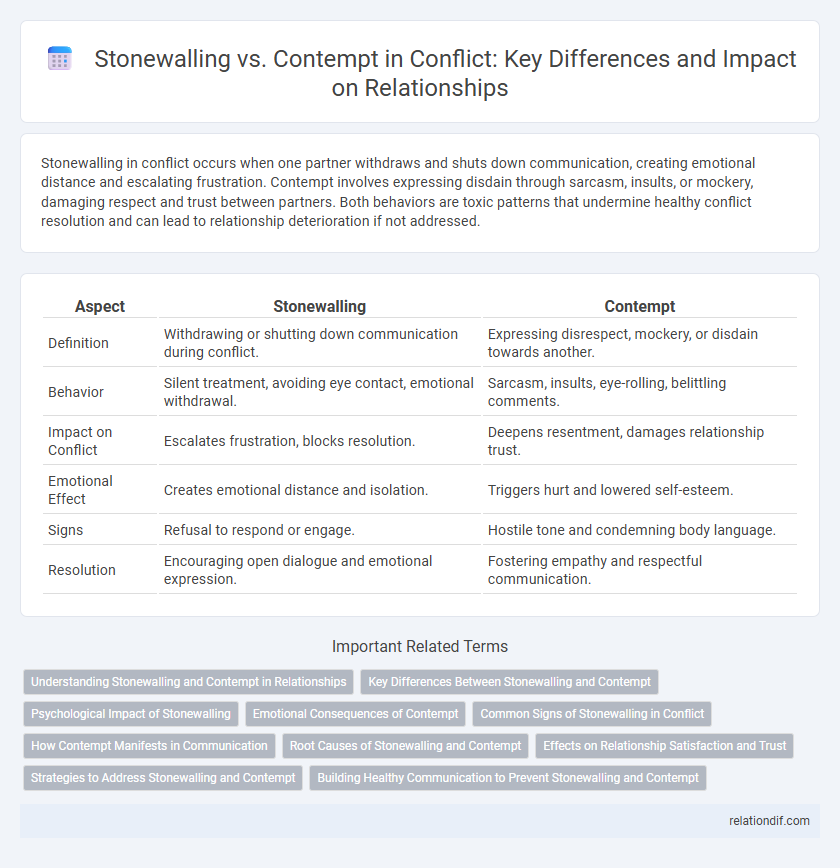Stonewalling in conflict occurs when one partner withdraws and shuts down communication, creating emotional distance and escalating frustration. Contempt involves expressing disdain through sarcasm, insults, or mockery, damaging respect and trust between partners. Both behaviors are toxic patterns that undermine healthy conflict resolution and can lead to relationship deterioration if not addressed.
Table of Comparison
| Aspect | Stonewalling | Contempt |
|---|---|---|
| Definition | Withdrawing or shutting down communication during conflict. | Expressing disrespect, mockery, or disdain towards another. |
| Behavior | Silent treatment, avoiding eye contact, emotional withdrawal. | Sarcasm, insults, eye-rolling, belittling comments. |
| Impact on Conflict | Escalates frustration, blocks resolution. | Deepens resentment, damages relationship trust. |
| Emotional Effect | Creates emotional distance and isolation. | Triggers hurt and lowered self-esteem. |
| Signs | Refusal to respond or engage. | Hostile tone and condemning body language. |
| Resolution | Encouraging open dialogue and emotional expression. | Fostering empathy and respectful communication. |
Understanding Stonewalling and Contempt in Relationships
Stonewalling occurs when one partner withdraws from communication, creating emotional distance and blocking resolution, while contempt involves expressing disdain or disrespect through sarcasm, ridicule, or hostile body language. Both behaviors significantly damage relationships by undermining trust and emotional connection, often escalating conflicts rather than resolving them. Recognizing the signs of stonewalling and contempt is crucial for couples to address underlying issues and rebuild healthy communication patterns.
Key Differences Between Stonewalling and Contempt
Stonewalling involves withdrawing from interaction, often by refusing to respond or engage, which serves as a defense mechanism in conflicts. Contempt is characterized by open expressions of disrespect, such as mocking or hostile sarcasm, aimed to belittle the other person. The key difference lies in stonewalling's silent avoidance versus contempt's active, aggressive disparagement.
Psychological Impact of Stonewalling
Stonewalling induces significant psychological distress by fostering feelings of isolation, frustration, and emotional abandonment in the recipient. This behavior disrupts healthy communication patterns, leading to increased anxiety and diminished trust within relationships. The chronic experience of stonewalling can contribute to long-term emotional damage, including lowered self-esteem and heightened vulnerability to depression.
Emotional Consequences of Contempt
Contempt in conflict triggers deep emotional wounds, often leading to feelings of worthlessness, resentment, and emotional pain in the targeted individual. Unlike stonewalling, which involves withdrawal and silence, contempt actively communicates disdain through sarcasm, eye-rolling, and hostile humor, intensifying emotional harm. Persistent contempt corrodes trust and emotional safety, increasing the risk of long-term relationship damage and psychological distress.
Common Signs of Stonewalling in Conflict
Common signs of stonewalling in conflict include prolonged silence, avoiding eye contact, and physically withdrawing from the discussion, which signals emotional shutdown rather than engagement. Victims of stonewalling often feel frustrated and unheard as their partner refuses to respond or acknowledges the issue, deepening the communication gap. This behavior can escalate tensions and hinder conflict resolution, contrasting with contempt, which typically involves overt hostility or disrespect.
How Contempt Manifests in Communication
Contempt in communication manifests through sarcasm, mockery, and hostile humor that belittles the partner's thoughts or feelings. Nonverbal cues such as eye-rolling, sneering, and dismissive gestures also convey deep disrespect and disdain in conflicts. This toxic behavior erodes trust and intimacy, often leading to emotional disengagement and relationship deterioration.
Root Causes of Stonewalling and Contempt
Stonewalling often stems from emotional overwhelm and a perceived inability to cope with conflict, leading individuals to withdraw as a protective mechanism. Contempt originates from deep-seated resentment, feelings of superiority, and chronic dissatisfaction, manifesting as disrespect and disdain toward a partner. Both behaviors are rooted in unresolved emotional pain and poor communication patterns that escalate relational tension.
Effects on Relationship Satisfaction and Trust
Stonewalling often leads to decreased relationship satisfaction by creating emotional distance and hindering effective communication, which erodes trust over time. Contempt, manifested through sarcasm, mockery, or hostile humor, severely undermines trust and predicts relationship dissatisfaction and eventual dissolution. Both behaviors disrupt emotional connection but contempt exerts a more toxic and immediate impact on the stability of relationships.
Strategies to Address Stonewalling and Contempt
Effective strategies to address stonewalling include practicing timed breaks during conflicts to prevent emotional flooding and encouraging open communication through active listening techniques. Combating contempt requires fostering empathy by expressing appreciation and reframing negative interpretations into constructive dialogue. Implementing cognitive-behavioral interventions and seeking couples therapy can also help partners develop healthier interaction patterns and reduce relational toxicity.
Building Healthy Communication to Prevent Stonewalling and Contempt
Building healthy communication to prevent stonewalling and contempt involves fostering open dialogue, active listening, and emotional validation between partners. Techniques like expressing needs without blame, practicing empathy, and taking breaks to de-escalate tension reduce the likelihood of withdrawal or hostile attitudes. Consistent use of positive communication patterns strengthens relationship resilience and decreases the risk of long-term damage caused by stonewalling and contempt.
stonewalling vs contempt Infographic

 relationdif.com
relationdif.com